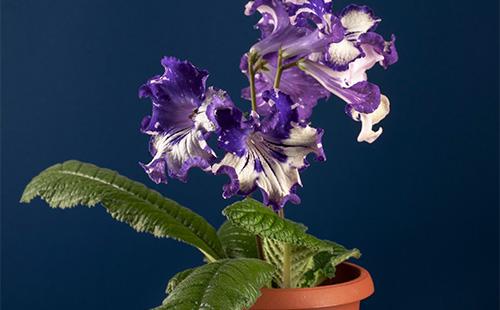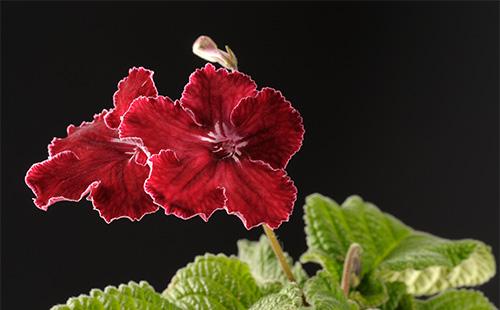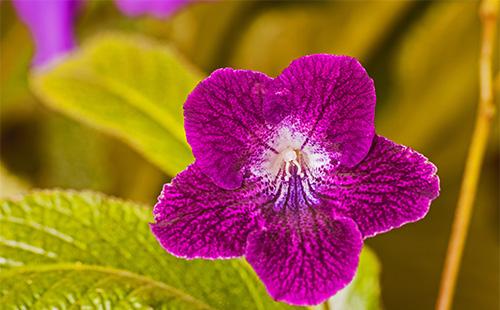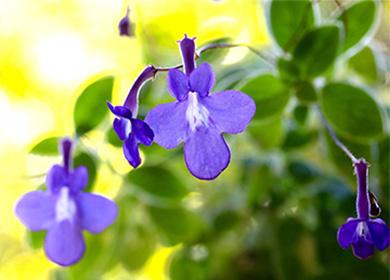The content of the article
In nature, there are annual and perennial species of streptocarpuses. The plant is a representative of the Gesneriaceae family, whose homeland is the tropical regions of Africa, Madagascar, Asia, and Thailand. "Twisted fruit" - this is the name of the flower. This is due to the ripe shape of the fruit, similar to a swirling spiral pod. Exotic plant with pubescent foliage, a shortened stem and a colorful color of flowers, at first glance, resembles a mixture of room violet andorchids.
Varieties of plants
In the natural environment, there are about 130 species of streptocarpuses. All of them are divided into three types.
- Univalent. The main leaf reaches a length of 1 m, a width of up to 0.5 m. In some varieties, several auxiliary leaves grow. It is characterized by abundant flowering by medium-sized inflorescences.
- Rosette (stemless). Represents most of the hybrid varieties for indoor cultivation. Large inflorescences of various colors are formed into lush rosettes; each individual flower reaches a few centimeters in diameter.
- Stalk. A type of plant creeping on the ground with small inflorescences. Abundantly shrubs, grows to a height of 50-60 cm.
Flower beds
For growing indoors, gardeners often prefer modern hybrid varieties, using natural species less and less. However, wild plants are perfect for landscaping a garden. Insects help pollinate streptocarpuses, but you can carry out the procedure yourself, pollinating pollen from a flower of one variety of another. The following five types are most commonly used.
- Royal (Rex). Leaves with a cannon, elongated, reach a length of 20-25 cm, a width of about 5 cm. The flowers can be paired or single, have a light lilac and lilac color with purple or violet stripes.
- Vendlan. A plant with a single large, broad leaf of dark green, almost 1 m long and 50 cm wide. It has a long peduncle, consisting of 10-20 flowers. The flowers are saturated purple, violet and blue, in diameter - up to 5cm. Propagated exclusively by seeds.
- Snow-white. The rosette appearance of the plant, the leaves of the wrinkled texture of green color grow up to 50 cm in length and up to 20 cm in width. Yellow strokes are marked on white flowers, purple blotches on the throat. It is characterized by abundant flowering.
- Rocky. Perennial appearance with small oval leaves. The stem grows 0.5 m in length, peduncles reach 7-10 cm. White flowers with a purple border at the edges of the petals.
- Big. It has only one leaf, extending to a maximum of 50 cm in width and up to 30 cm in width. At the top of a half-meter stalk there is a racemose inflorescence with bright purple flowers.
Indoor
To date, more than 1000 hybrid varieties of streptocarpuses of the rosette type have been developed. Due to varietal diversity, the plant has gained popularity both among amateur gardeners and among collectors. Peduncles of hybrid exotics at home reach a height of about 25 cm, leaves up to 30 cm, and the diameter of the flower varies from 3 to 9 cm.
Petals of flowers are smooth, terry, corrugated. Along with the usual lilac and lilac flowers, one can find white, blue, yellow, red, violet and even black flowers bred by breeders with smooth transitions of color and unusual patterns, with or without aroma. Many bred varieties are divided into five groups.
- Two-tone. The outer edges of the petals and the neck have different contrasting shades (lilac-yellow, white-purple and others).
- Fantasy. Petals are covered with a variety of patterns and texture color: stripes, spots, mesh, "venous" weaves. Flowers have more than two shades.
- Terry, semi-terry. Rich velvety petals with dark veins and lighter edges. They have short peduncles and rich flowering.
- Corrugated. Dense petals with corrugated (wavy) edges of various colors.
- Miniature, variegated. A miniature plant with narrow leaves and a compact lush rosette of flowers of various colors and petal textures.
Care for streptocarpus at home
In the cold season, some varieties require a dormant period, which is why caring for streptocarpus in winter is somewhat different from its maintenance in summer.
Lighting and temperature
Streptocarpuses grow well in natural and artificial lighting. Avoid direct exposure to the scorching sun on the flower - he loves plentiful, but diffused light. The optimal location on the windowsills from the southeast or southwest side.
For year-round flowering of streptocarpus in winter, it is necessary to use fluorescent lamps or phytolamps to ensure a daylight hours of at least twelve hours. Otherwise, the plant will be at rest and will please with new flowering only with the advent of spring.
The optimal temperature range in summer varies between 20-25 ° C, in winter, if the plant does not bloom, the permissible level is 15-19 ° C. However, for young seedlings and rooting cuttings, do not lower the temperature below 22 ° C.
Moderate watering
The gentle roots of the plant do not tolerate excessive watering. Too wet soil with high acidity can lead to decay of the root system. Watering is best done in the evening with settled or distilled water at room temperature. Humidification of the soil is carried out only after the layer dries to the middle of the pot.
It is recommended to water streptocarpuses along the edge of the flower pot or pour water into the pan; the remaining moisture in the pan must be drained.
The plant loves moist air, but categorically it is impossible to spray peduncles and leaves with water! Dark spots may form from drops of water on delicate petals and leaves. To create a flower with optimal humidity, you can install a container of water next to it, use household humidifiers, or periodically spray water around the plant.
Regular feeding
Growing streptocarpus at home requires periodic top dressing to accelerate growth, active flowering and strengthen flower immunity. A complex mineral fertilizer is suitable for this procedure.Fertilize for the first time a month after the transplant, then repeat every 10-14 days. Concentration should be done two times lower than indicated on the manufacturer's packaging. The flower perfectly assimilates both root and foliar top dressing.
During the growing season, you can fertilize streptocarpus more often - once a week, during dormancy, feeding is not required.
For young seedlings that are just starting to form leaves, it is necessary to use preparations for decorative deciduous plants with a high nitrogen content. When flower buds appear, switch to top dressing for flowering species with a predominance of potassium and phosphorus components. The best nutrient mixture for streptocarpuses: nitrogen, phosphorus and potassium in a ratio of 2: 1: 2.
Planned move to a new pot
Another rule on how to care for streptocarpus is to provide the plant with an annual transplant regardless of age. The most suitable time for this is the end of winter or the beginning of spring.

Soil preparation and capacity selection
For self-preparation of the soil, it is necessary to mix two parts of turfy land, one part of leafy land, sand and humus. You can also use ready-made storey primer for Saintpoly. Based on the reviews of flower growers, 1/2 part of vermiculite, perlite, sphagnum moss and crushed activated carbon must be added to a purchased or personally prepared soil mixture. These components make the soil more loose and prevent the possibility of rotting of the roots.
Capacity for landing can be used in a classic form, but not too deep. The pot should be with drainage holes and smooth inner walls - thin flower roots can be damaged on the rough and porous surface of the clay container. The root system grows over the year, completely braiding the soil, so with a subsequent transplant, you need to choose a pot 1.5-2 cm larger in diameter.
Transplant process
Features In overgrown streps, “babies” appear, which should be divided along with the roots and planted in individual containers. The transplant process is carried out in eight stages.
Procedure
- Moisten the soil in the pot and gently remove the flower along with the ground.
- Free the roots from the old earth and rinse under warm running water.
- Remove damaged roots. If the healthy roots are too long - shorten a little.
- At the bottom of the flower pot, place expanded clay or foam drainage 2-3 cm high.
- Soil mixture fill a third of the tank.
- Position the streptocarpus in the center of the pot and fill the remaining space with soil to the root neck.
- Pour the soil around the edge of the flower pot and spot the plant in the shade.
- When the growth process begins, put the flower in a familiar place with diffused lighting.
Breeding species
Streptocarpus is a unique flower that multiplies by almost any part of the mother plant. Specialists distinguish three methods of reproduction: by seeds of the fetus, by dividing a leaf outlet and cuttings of leaves. The latter method will allow rooting streptocarpus without roots.
Seeds
Features In order to grow streptocarpus from seeds, seed should be bought from a trusted brand in specialized stores. Collected on their own will not save the hybrid properties of the plant. Sowing technology is simple. You can spend at any time of the year, but the ideal period is the beginning of March.
Procedure
- Prepare the soil mixture by combining the sand with peat in equal proportions.
- Place the substrate in a transparent plastic container and moisten with water using a spray bottle.
- Sow the seeds from above onto the soil without burrowing into the ground.
- Place a glass or transparent bag on top of the container and place in a warm, lit area. Avoid direct sunlight.
- Ventilate the sowing container daily, maintain the soil moisture level.
- The first shoots will appear in 15-20 days, after which the container can not be covered.
- When two leaves appear, make the first pick of the plant, transplant the sprouts into a larger container.
- After a month and a half, make a second pick, placing each seedling in a separate container with soil as for an adult plant.

Division of the outlet
Features This method of reproduction is best used during the planned transplantation of an adult flower in the spring. A reliable method by dividing is suitable for beginner growers, and the new streptocarpus will bloom quite quickly.
Procedure
- Use a sharp knife to cut a portion from the leafy outlet of the mother plant.
- Dry the cut, treat with finely divided activated carbon.
- Place in a glass with purified non-cold water 1.5-2 cm.
- In seven to ten days, the first roots will appear, and another two weeks later - new leafy sockets.
- When new leaves appear, plant the rooted plant in the soil substrate and expect the first flower stalk.
Cuttings leaf
Features Most of the varieties of the Gesneriaceae family give new shoots directly from the leaf. For this method, you should choose a young healthy leaf without signs of illness. Propagation of streptocarpuses by a leaf fragment will give the first flowering in two to three months.
Procedure
- With a sharp blade of a knife, cut the central vein of the sheet, cut the slices with crushed activated carbon.
- Pre-treat the container with fungicide and cover it with prepared soil substrate.
- Plant the finished parts of the leaf with a slice down, deepening into the third part of the handle at an angle of 45 ° C, at a distance of at least 3 cm from each other.
- Moisten the leafy cuttings, cover with a transparent film and place in a warm place with diffused lighting.
- Water the cuttings through the pan and ventilate daily.
- After a couple of weeks, the first roots will appear, and after a half to two months, new leaves from the side veins of the cuttings will appear.
- Carefully separate the strong leafy sockets and plant them in a new pot.

Disease treatment
Streptocarpus is unpretentious in leaving, but nevertheless certain maintenance rules must be observed. Systematic "care" errors will inevitably lead to flower diseases. Based on the following table, you can recognize the symptoms in time and take action.
Table - Treatment of streptocarpous diseases
| Symptoms of the disease | Cause | Method of treatment |
|---|---|---|
| Leaves fade | - lack of moisture | - Strengthen watering |
| Leaves dry | - dry air; - cramped pot | - Humidify the air in the room; - plant a plant |
| Leaves turn yellow | - Lack of nutrition | - Feed with complex mineral fertilizer |
| Rusty plaque on the leaves | - Excessive watering; - excess fertilizer | - reduce watering; - let the soil dry completely; - transplant into new soil; - reduce the frequency of feeding |
| Flower buds are getting dark | - Increased air temperature | - Move to a cooler room |
| Gray plaque (rot) on the leaves | - high humidity; - low air temperature | - Remove affected parts; - treat with fungicide; - reduce watering |
| Powdery mildew (white coating) on the leaves | - Increased dampness; - low air temperature; - high nitrogen content in the soil; - frequent watering | - Rinse the whole flower under warm running water; - thin out, remove old leaves; - treat with fungicide; - transplant into new soil; - reduce nitrogen fertilizers; - add potassium phosphorus |
| Root rot (wilting, dark spots) | - Excessive watering; - low air temperature | - Transplant with a complete replacement of the soil; - remove damaged sections of the root system; - sprinkle slices with crushed charcoal; - reduce watering |
Pest control
Streptocarpus can affect some pests. The first rule is to isolate the diseased plant in time. A correctly diagnosed diagnosis will help to revive the flower and save it from death. The following table will tell you how to recognize and neutralize the enemy.
Table - Pest control of streptocarpus
| Pests | Signs of defeat | Resuscitation |
|---|---|---|
| Aphid | - The appearance of a small insect of orange or green color; - sticky coating on the leaves; - twisting and deformation of foliage | - Remove damaged parts of the plant; - carry out treatment with an insecticidal preparation |
| Weevil | - The appearance of black wingless insects; - the formation of holes on the surface and along the edges of the leaves |
|
| Shield | - The appearance of yellow spots; - complete yellowing and death of the leaves | - Rinse the plant under running water; - carry out treatment with an insecticidal preparation; - land in new soil |
| Mealybug | - The appearance of a small white insect on the bottom of the leaf; - yellowing and falling of leaves | - Soap solution to remove pests from the surface of the leaves; - carry out insecticide treatment several times |
| Whitefly | - The appearance of small white midges; - yellowing and falling of leaves | - Remove the affected foliage; - spray with an insecticide once a week for two months |
| Thrips | - The appearance of brown insects of an elongated shape (2 mm); - the formation of whitish spots; - darkening of foliage | - Conduct treatment with an insecticidal drug; - increase the humidity in the room |
| Spider mite | - Loss of color in the leaves; - the appearance of a thin web; - whitish spots on the leaves | - Wipe the leaves with a soapy solution; - carry out treatment with an insecticidal preparation; - increase the humidity in the room |
| Sciarida fly | - The appearance of small black flies on the surface of the soil; - stunting and wilting of the plant - the pest feeds on young roots | - Make a complete replacement of the soil; - rinse the roots; - remove damaged parts; - reduce the watering regime; - lower the room temperature |
Reasons for the lack of flowering
Most of the representatives of this species of flora is characterized by abundant flowering from spring to late autumn. Some varieties bloom year round. Depending on the hybrid, flowering may occur already on the "baby", and may begin later, after the complete formation of deciduous rosettes. The main reasons for the lack of flowering can be poor lighting, excessive watering and inadequate nutrition.
How to care for streptocarpus during flowering - timely cut wilted peduncles along with flowers at a distance of about 1 cm from the leaves. In addition, old leaves of the plant should also be removed, since new stalks will no longer appear from their rosettes, and they will take away nutrients from the plant.
Reviews: “He sits on a windowsill and blooms plentifully for the second month”
The value of streptocarpuses in continuous flowering, my hybrid forms bloom for about 8 months a year with white, pink, purple bells. I have a classic purple with yellow veins. In care, the plant is quite simple, simpler than uzambar violets or gloxinia.
Olga https://floristics.info/ru/s-rus/streptokarpus.html
I just recently, this summer, began to grow streptocarpuses. I bought leaves, now baby babies grow from them. I bought some plants by small children. A part stands and blooms on the loggia - they like coolness. Part under the lamps on the window (the window is also constantly open to the loggia). The main thing is not to fill, but they are very unpretentious! If they grow to bloom, they bloom constantly.
Olyunya, https://forum.bestflowers.ru/t/streptokarpus-uxod-v-domashnix-uslovijax.109530/
In the summer I try to water more often, I spend watering only when the topsoil dries out.I use complex mineral fertilizer for top dressing, but I make the concentration weaker than indicated in the instructions. Periodically, I spill the ground with a drug against pests.
Elena Saveta, http://vsaduidoma.com/2013/11/13/streptokarpusy-foto-uxod-v-domashnix-usloviyax-i-razmnozhenie-cvetov/
I am a beginner grower, capricious flowers do not survive. Somehow, my mother traded a violet for a flower with the strange name streptocarpus. He did not bloom then, and there were a lot of it in the pot. Therefore, we planted it in two pots in the ground for the saints. After a few weeks, my streptocarpus grew, became an adult flower and began to produce peduncles. I didn’t even expect such agility from him. And most importantly - he is not whimsical at all. He sits on a windowsill and blooms plentifully for the second month, occasionally watering it and that’s it.
Shooik, http://irecommend.ru/content/streptokarpus-streptocarpus

